[English] 日本語
 Yorodumi
Yorodumi- PDB-6efk: Crystal structure of the human CHIP TPR domain in complex with a ... -
+ Open data
Open data
- Basic information
Basic information
| Entry | Database: PDB / ID: 6efk | ||||||
|---|---|---|---|---|---|---|---|
| Title | Crystal structure of the human CHIP TPR domain in complex with a 5mer acetylated HSP70 peptide | ||||||
 Components Components |
| ||||||
 Keywords Keywords |  LIGASE / C-terminus of Hsc70-interacting protein / LIGASE / C-terminus of Hsc70-interacting protein /  Heat Shock Protein 70 / CHIP / Heat Shock Protein 70 / CHIP /  HSP70 HSP70 | ||||||
| Function / homology |  Function and homology information Function and homology informationpositive regulation of chaperone-mediated protein complex assembly / regulation of glucocorticoid metabolic process / ubiquitin conjugating enzyme complex / positive regulation of ERAD pathway / positive regulation of mitophagy / ERBB2 signaling pathway / positive regulation of smooth muscle cell apoptotic process / nuclear inclusion body /  misfolded protein binding / protein folding chaperone complex ...positive regulation of chaperone-mediated protein complex assembly / regulation of glucocorticoid metabolic process / ubiquitin conjugating enzyme complex / positive regulation of ERAD pathway / positive regulation of mitophagy / ERBB2 signaling pathway / positive regulation of smooth muscle cell apoptotic process / nuclear inclusion body / misfolded protein binding / protein folding chaperone complex ...positive regulation of chaperone-mediated protein complex assembly / regulation of glucocorticoid metabolic process / ubiquitin conjugating enzyme complex / positive regulation of ERAD pathway / positive regulation of mitophagy / ERBB2 signaling pathway / positive regulation of smooth muscle cell apoptotic process / nuclear inclusion body /  misfolded protein binding / protein folding chaperone complex / cellular response to misfolded protein / ubiquitin-ubiquitin ligase activity / RIPK1-mediated regulated necrosis / misfolded protein binding / protein folding chaperone complex / cellular response to misfolded protein / ubiquitin-ubiquitin ligase activity / RIPK1-mediated regulated necrosis /  chaperone-mediated autophagy / protein quality control for misfolded or incompletely synthesized proteins / TPR domain binding / ERAD pathway / SMAD binding / protein monoubiquitination / protein K63-linked ubiquitination / positive regulation of proteolysis / negative regulation of smooth muscle cell apoptotic process / chaperone-mediated autophagy / protein quality control for misfolded or incompletely synthesized proteins / TPR domain binding / ERAD pathway / SMAD binding / protein monoubiquitination / protein K63-linked ubiquitination / positive regulation of proteolysis / negative regulation of smooth muscle cell apoptotic process /  R-SMAD binding / protein maturation / protein autoubiquitination / endoplasmic reticulum unfolded protein response / R-SMAD binding / protein maturation / protein autoubiquitination / endoplasmic reticulum unfolded protein response /  ubiquitin ligase complex / ubiquitin ligase complex /  Hsp70 protein binding / Hsp70 protein binding /  heat shock protein binding / Downregulation of TGF-beta receptor signaling / positive regulation of protein ubiquitination / G protein-coupled receptor binding / response to ischemia / Regulation of TNFR1 signaling / negative regulation of transforming growth factor beta receptor signaling pathway / heat shock protein binding / Downregulation of TGF-beta receptor signaling / positive regulation of protein ubiquitination / G protein-coupled receptor binding / response to ischemia / Regulation of TNFR1 signaling / negative regulation of transforming growth factor beta receptor signaling pathway /  Hsp90 protein binding / RING-type E3 ubiquitin transferase / Hsp90 protein binding / RING-type E3 ubiquitin transferase /  regulation of protein stability / tau protein binding / Regulation of necroptotic cell death / Downregulation of ERBB2 signaling / regulation of protein stability / tau protein binding / Regulation of necroptotic cell death / Downregulation of ERBB2 signaling /  kinase binding / Z disc / Regulation of PTEN stability and activity / protein polyubiquitination / ubiquitin-protein transferase activity / Regulation of RUNX2 expression and activity / kinase binding / Z disc / Regulation of PTEN stability and activity / protein polyubiquitination / ubiquitin-protein transferase activity / Regulation of RUNX2 expression and activity /  ubiquitin protein ligase activity / ubiquitin protein ligase activity /  MAPK cascade / positive regulation of proteasomal ubiquitin-dependent protein catabolic process / Antigen processing: Ubiquitination & Proteasome degradation / protein-macromolecule adaptor activity / cellular response to heat / protein-folding chaperone binding / cellular response to hypoxia / ubiquitin-dependent protein catabolic process / proteasome-mediated ubiquitin-dependent protein catabolic process / protein stabilization / protein ubiquitination / MAPK cascade / positive regulation of proteasomal ubiquitin-dependent protein catabolic process / Antigen processing: Ubiquitination & Proteasome degradation / protein-macromolecule adaptor activity / cellular response to heat / protein-folding chaperone binding / cellular response to hypoxia / ubiquitin-dependent protein catabolic process / proteasome-mediated ubiquitin-dependent protein catabolic process / protein stabilization / protein ubiquitination /  DNA repair / DNA repair /  ubiquitin protein ligase binding / ubiquitin protein ligase binding /  enzyme binding / enzyme binding /  endoplasmic reticulum / protein homodimerization activity / endoplasmic reticulum / protein homodimerization activity /  mitochondrion / mitochondrion /  nucleoplasm / nucleoplasm /  nucleus / nucleus /  cytosol / cytosol /  cytoplasm cytoplasmSimilarity search - Function | ||||||
| Biological species |   Homo sapiens (human) Homo sapiens (human) | ||||||
| Method |  X-RAY DIFFRACTION / X-RAY DIFFRACTION /  SYNCHROTRON / SYNCHROTRON /  MOLECULAR REPLACEMENT / Resolution: 1.5 Å MOLECULAR REPLACEMENT / Resolution: 1.5 Å | ||||||
 Authors Authors | Basu, K. / Ravalin, M. / Bohn, M.-F. / Craik, C.S. / Gestwicki, J.E. | ||||||
 Citation Citation |  Journal: Nat.Chem.Biol. / Year: 2019 Journal: Nat.Chem.Biol. / Year: 2019Title: Specificity for latent C termini links the E3 ubiquitin ligase CHIP to caspases. Authors: Ravalin, M. / Theofilas, P. / Basu, K. / Opoku-Nsiah, K.A. / Assimon, V.A. / Medina-Cleghorn, D. / Chen, Y.F. / Bohn, M.F. / Arkin, M. / Grinberg, L.T. / Craik, C.S. / Gestwicki, J.E. | ||||||
| History |
|
- Structure visualization
Structure visualization
| Structure viewer | Molecule:  Molmil Molmil Jmol/JSmol Jmol/JSmol |
|---|
- Downloads & links
Downloads & links
- Download
Download
| PDBx/mmCIF format |  6efk.cif.gz 6efk.cif.gz | 128.9 KB | Display |  PDBx/mmCIF format PDBx/mmCIF format |
|---|---|---|---|---|
| PDB format |  pdb6efk.ent.gz pdb6efk.ent.gz | 98.3 KB | Display |  PDB format PDB format |
| PDBx/mmJSON format |  6efk.json.gz 6efk.json.gz | Tree view |  PDBx/mmJSON format PDBx/mmJSON format | |
| Others |  Other downloads Other downloads |
-Validation report
| Arichive directory |  https://data.pdbj.org/pub/pdb/validation_reports/ef/6efk https://data.pdbj.org/pub/pdb/validation_reports/ef/6efk ftp://data.pdbj.org/pub/pdb/validation_reports/ef/6efk ftp://data.pdbj.org/pub/pdb/validation_reports/ef/6efk | HTTPS FTP |
|---|
-Related structure data
| Related structure data | 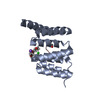 6nsvC  3q49S S: Starting model for refinement C: citing same article ( |
|---|---|
| Similar structure data |
- Links
Links
- Assembly
Assembly
| Deposited unit | 
| ||||||||
|---|---|---|---|---|---|---|---|---|---|
| 1 | 
| ||||||||
| 2 | 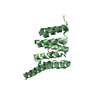
| ||||||||
| Unit cell |
|
- Components
Components
| #1: Protein | Mass: 15222.310 Da / Num. of mol.: 2 Source method: isolated from a genetically manipulated source Source: (gene. exp.)   Homo sapiens (human) / Gene: STUB1, CHIP, PP1131 / Production host: Homo sapiens (human) / Gene: STUB1, CHIP, PP1131 / Production host:   Escherichia coli BL21(DE3) (bacteria) Escherichia coli BL21(DE3) (bacteria)References: UniProt: Q9UNE7, RING-type E3 ubiquitin transferase #2: Protein/peptide | Mass: 629.657 Da / Num. of mol.: 2 / Source method: obtained synthetically / Source: (synth.)   Homo sapiens (human) Homo sapiens (human)#3: Chemical | ChemComp-NA / | #4: Water | ChemComp-HOH / |  Water Water |
|---|
-Experimental details
-Experiment
| Experiment | Method:  X-RAY DIFFRACTION / Number of used crystals: 1 X-RAY DIFFRACTION / Number of used crystals: 1 |
|---|
- Sample preparation
Sample preparation
| Crystal | Density Matthews: 2 Å3/Da / Density % sol: 38.4 % |
|---|---|
Crystal grow | Temperature: 298 K / Method: vapor diffusion, hanging drop / Details: 0.4 M CaCl2, 0.1 M HEPES (pH 7.5), 25% PEG 4000 |
-Data collection
| Diffraction | Mean temperature: 100 K / Serial crystal experiment: N |
|---|---|
| Diffraction source | Source:  SYNCHROTRON / Site: SYNCHROTRON / Site:  ALS ALS  / Beamline: 8.3.1 / Wavelength: 1.116 Å / Beamline: 8.3.1 / Wavelength: 1.116 Å |
| Detector | Type: DECTRIS PILATUS 6M / Detector: PIXEL / Date: Oct 8, 2017 |
| Radiation | Protocol: SINGLE WAVELENGTH / Monochromatic (M) / Laue (L): M / Scattering type: x-ray |
| Radiation wavelength | Wavelength : 1.116 Å / Relative weight: 1 : 1.116 Å / Relative weight: 1 |
| Reflection | Resolution: 1.5→39.95 Å / Num. obs: 40943 / % possible obs: 96.64 % / Redundancy: 11.5 % / Net I/σ(I): 9.42 |
| Reflection shell | Resolution: 1.5→1.554 Å / Redundancy: 7.1 % / Mean I/σ(I) obs: 1.55 / Num. unique obs: 3686 / % possible all: 86.34 |
- Processing
Processing
| Software |
| |||||||||||||||||||||||||||||||||||||||||||||||||||||||||||||||||||||||||||||||||||||||||||||||||||||||||
|---|---|---|---|---|---|---|---|---|---|---|---|---|---|---|---|---|---|---|---|---|---|---|---|---|---|---|---|---|---|---|---|---|---|---|---|---|---|---|---|---|---|---|---|---|---|---|---|---|---|---|---|---|---|---|---|---|---|---|---|---|---|---|---|---|---|---|---|---|---|---|---|---|---|---|---|---|---|---|---|---|---|---|---|---|---|---|---|---|---|---|---|---|---|---|---|---|---|---|---|---|---|---|---|---|---|---|
| Refinement | Method to determine structure : :  MOLECULAR REPLACEMENT MOLECULAR REPLACEMENTStarting model: 3Q49 Resolution: 1.5→39.946 Å / SU ML: 0.17 / Cross valid method: FREE R-VALUE / σ(F): 1.33 / Phase error: 28.2
| |||||||||||||||||||||||||||||||||||||||||||||||||||||||||||||||||||||||||||||||||||||||||||||||||||||||||
| Solvent computation | Shrinkage radii: 0.9 Å / VDW probe radii: 1.11 Å | |||||||||||||||||||||||||||||||||||||||||||||||||||||||||||||||||||||||||||||||||||||||||||||||||||||||||
| Refinement step | Cycle: LAST / Resolution: 1.5→39.946 Å
| |||||||||||||||||||||||||||||||||||||||||||||||||||||||||||||||||||||||||||||||||||||||||||||||||||||||||
| Refine LS restraints |
| |||||||||||||||||||||||||||||||||||||||||||||||||||||||||||||||||||||||||||||||||||||||||||||||||||||||||
| LS refinement shell |
|
 Movie
Movie Controller
Controller


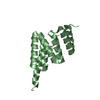
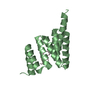
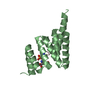
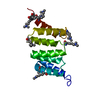



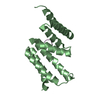
 PDBj
PDBj










